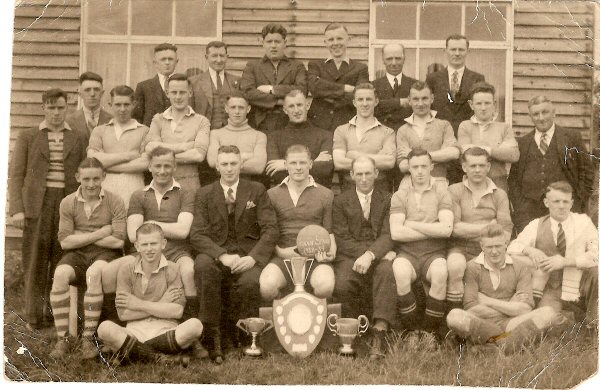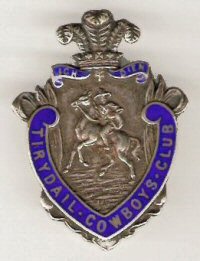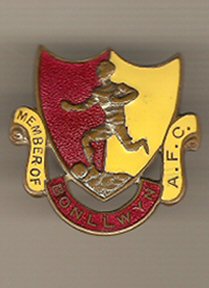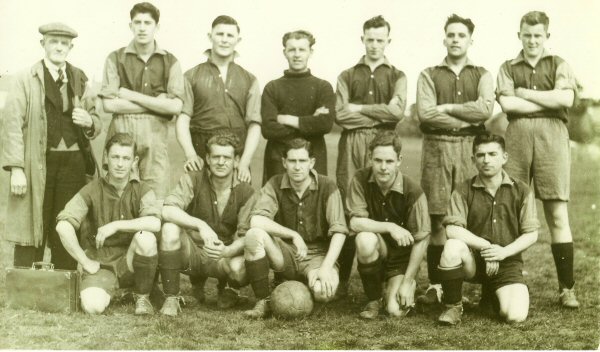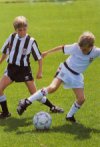AMMANFORD TOWN
ASSOCIATION FOOTBALL CLUBwith a brief history of football in Ammanford
Rugby may be the national sport of Wales but football is the national sport of choice, there being far more soccer than rugby players and clubs in the country. In 2003 there were 239 clubs affiliated to the Welsh Rugby Union while there are about 750 soccer clubs in Wales. Similarly, too, for Ammanford and its immediate surroundings, where the number of soccer clubs has, in the past at least, exceeding the number of rugby clubs. Ammanford United, Pullman's, Ammanford Bears, Betws, Ammanford Town, Tirydail Cowboys, Bonllwyn, Pantyffynnon, Waterloo Wanderers and Cathan Stars (playing in Garnswllt) have all had their own soccer teams and grounds in the last fifty years or so.
Earlier still there were even more teams: in November 12th, 1921, the Amman Valley and District Association Football League table showed the followng clubs (from first to last positions): Pantyffynnon Great Western Railway, Tai'rgwaith Working Men's Club, Teilo United, Brynamman, Llandeilo, Mid-Amman, Ammanford Albions, Llandybie, Cross Hands, Tairgwaith, Gorsddu, Bonllwyn and Cwmgors. We can see from this that there were enough employees at Pantyffynnon railway station, along with its engine repair shed and marshalling yards, for a football team. Likewise, the tiny village of Tairgwaith fielded two teams: one from the village itself and one from the working men's club. But there were three collieries in the village (Maerdy, Steer Pit and East Pit), to yield a plentiful supply of young and fit men with plenty of energy to burn. Only a mile away is Cwmgors, also with its colliery, and likewise with its soccer and rugby teams. While many Tairgwaith and Cwmhgors men played in the local rugby teams there was no shortage of villagers choosing to play soccer.
Cathan Stars AFC in Garnswllt. The football is dated 1938/39, and this was the last team before war broke out on Sept 2nd 1939. Cathan would re-form after the war but Fred Russ ( third row down, far right,) would be a founder member of Bonllwyn football club after hostilities ended in 1945 (see Bonllwyn AFC photograph below) But all sport, including football, stopped during World War Two and when peace returned after 1945 it was with a new crop of football teams. All the rugby clubs re-formed after the war but some of the soccer clubs disappeared, to be replaced by new ones. Tirydail Cowboys was of the new post-war teams, joining some of the longer established teams that had re-formed post-war.
Lapel badge for Bonllwyn football club
Bonllwyn AFC around 1947. The teams colours were red shirts with yellow sleves, the same colours as the (fictional) Melchester Rovers, the club of cartoon hero Roy of the Rovers. Standing, left to right: Will Llewelyn, Les Williams, Benny Jones, Gerwyn Williams, David Owen Griffiths, John Connolly, Eddie Chard. Seated, left to right: Bryn Jones, Fred Russ, Bryn Williams, Jeff Jones, Bryn 'Bach' Jones. Photograph and names provided by Wendy Howell from Bonllwyn. By 1991, though, all but two of these clubs had disbanded, leaving just Ammanford Town AFC (formally Betws AFC) and Ammanford Athletic AFC (itself the result of an earlier merger of Ammanford United and Ammanford Bears in the 1970s).
Ammanford Bears
This team was founded in 1950/51 with the assistance of Father Mulroy, the priest at Ammanford Catholic Church in Margaret Street, but the team itself was non-denominational. The local Church of St Michael's had a youth club based in their Church Hall on Wind Street called Cymru'r Groes (Cross of Wales) who also had a youth team for a while in the 1960s under the leadership of a particularly enthusiastic curate, but that was a short-lived venture. One founder-member of Ammanford Bears was Wallace Davies from Margaret Street who has kindly sent this e-mail to the website:The first football pitch on which the Bears played was at the top end of Margaret Street and Union Street, behind Thomas's bakery, known as the 'Corn field'. The first team the Bears put out had five boys who lived in Margaret Street, four boys from Walter Road, one boy from Church Street, and one from Brynteg Terrace, and we had to play friendly games only. The first set of goalposts which we had were made from fir trees which we collected ourselves from woods not far from the field in which we played. (Don't tell anyone – we cut the trees down!) The names of the boys who took part in the first Ammanford Bears team were:
– Goalkeeper: Brian Evans (Captain)
– Right Back: Brian Davies (known as Tiny)
– Left Back: Wallace Davies (that's me).
– Left Half: Stan Jolley.
– Centre Half: Geoff Tucker.
– Right Half: Ronnie Davies.
– Right Wing: Malcolm Davies (my brother)
– Inside Right: Graham Robinson.
– Centre Forward: Gareth Davies.
– Inside Left: Dillwyn Davies, (brother of Gareth)
– Left Wing: Glen Jones.
I hope that this info helps you to understand how the Ammanford Bears started. Our fixture Secretary, who organised our games, was Geoff Tucker. I must say, that Father Mulroy helped us enormously to get this team up and running. (From an e-mail dated 24 August 2005.)Glanamman Football Club
A similarly inventive approach to constructing goalposts was displayed just three miles up the Amman Valley when Glanamman Football Club was formed at about the same time. Their goalkeeper Dai Davies, who went on to gain 52 caps for Wales, has left us memories of his life and football career in his autobiogarphy Never Say Dai, published in 1986. The first chapter gives a nostalgic glimpse into the social conditions of a small mining community in the 1950s:Once the Amman Valley and District league had been formed, the village set up their own committee, men who suddenly became more important than the gods for the boys. For they had the power to select who should be in, or who should not be in the Glanaman Football team. At that time, my brother was almost always in that team, and that was one of the times I felt most frustrated that I was four years younger than him ...
.....But my father, the big force behind the scenes, knew perfectly well how to cheer me up. Every Friday night was a night of sleepless excitement thinking of all the tasks I had to perform the next morning in preparation for the big match. I have seldom been more eager, and never has the quarter mile from our house to the playing field, over the coal tip, along the old railway line, over the bridge, short legs running to keep up with my father's measured tread, been more of a pleasure.
.....The first task, more often than not, was to clear the water collected in the goalmouth. An old baked beans tin, hidden between times securely in the shadow of a nearby outcrop of rock, served as a baler. I wonder how many goalkeepers have appreciated the efforts of that small boy on all fours extracting the last drop of sticky wet black mud off his goal line. Meanwhile my father would be marking the pitch. He would cut a narrow furrow along the wings, and along the centre line filling it carefully with sawdust, before the advent of new technology, the chalk barrow. Then the nets would be hung in place on the iron goalposts, posts incidentally made by Uncle Dai, my mother's brother, who was a blacksmith at Betws Colliery where my father worked.
.....No one could say that the Glanaman Football Club did not have a proper changing room. For the purpose there was a luxurious corrugated iron shed – a single room divided into two by an old coalburning stove on which stood two enormous cauldrons. The last pre-match task of the assistant groundsman was to carry water from the nearby River Aman to fill those containers. It was incidentally the responsibility of the players to provide fuel for the fire, and as they arrived, the lump of coal in their sports bag was as important a piece of equipment as their boots.(Never Say Dai, the autobiography of Wales goalkeeper Dai Davies, Chapter 1, published by Siop y Siswrn, Mold, Clwyd, 1986)
That should make today's football players realise how lucky they are in comparison.
The 'Pullman Springfilled' factory in New Road, Ammanford, fielded a team drawn from its own workforce. The Pullman's factory, built in 1943 and occupied by the Pullman company in 1945, had about 1,100 employees at its peak in the fifties and was able to form a soccer team drawn entirely from its employees. As the work force dwindled throughout the sixties however, the football team became independent of the company, and the players drifted off to play for the other local teams, particularly Ammanford Bears. Pullman's themselves ceased trading in 1967.
In 1992 Ammanford Town AFC and Ammanford Athletic AFC also merged to form Ammanford AFC, now the only soccer club in the town, currently running three teams – in the Welsh League, Welsh League Reserve Division and the Carmarthenshire League, along with junior teams (see below). The club shares its games between the Rice Street ground in Betws, the home of the former Betws clubs, and the recreation ground in Ammanford, where the Ammanford clubs had previously played.
It's no wonder, really, that more people choose to play soccer than the national sport; it is after all an easier game to play than rugby, and games can take place even on hard surfaces such as streets and school yards, where rugby, with its ferocious tackling, cannot safely be played, at least not by the sane of mind. This is at least partly the reason why soccer has become the only truly global sport. All that is needed is a ball and a game can be played in the slums of Brazil or on a village dirt track in Africa as readily as on a custom-built sports ground in the developed world.
And soccer can be played by people of all shapes and sizes – you don't need to be a lumbering giant to be successful with a round ball at your twinkling toes. Nor do you have to take your life in your hands, as you do whenever the oval shaped ball arrives in your possession during a game of rugby. There can be fewer sights more terrifying than a pack of sixteen stone monsters bearing down on you, intent on wreaking mayhem on your poor, defenceless body, the thoughts in their primitive minds best left unspoken. Folk with murder in the hearts and little, if anything, in their brains, do not make a pretty sight, and are better left to their own devices.
English 'gentlemen' from the public schools may have invented rugby but the gentle part of the word is soon abandoned on the field of play. Thirty lager louts running around in their underwear might best describe rugby football, perhaps, but soccer is a more civilized affair altogether (well, usually, anyway), and if rugby is a game created by gentlemen, then soccer is a game played by gentlemen. Plenty of scope for discussion there, no doubt.
But back to Ammanford AFC. What follows is a brief history of the club which has been summarised from 'Betws Mas O'r Byd' (Betws Beyond the World), a history of the village of Betws published by Betws History Group in 2001.
Ammanford AFC – Club History
The club was founded sometime during 1945 and 1946, with its headquarters at the Coopers Hotel, when Mr Vic Grove donated the gift of a chicken for a raffle and from the revenue came the beginning of the club.Association football had been played at Betws in the 1920s by Ammanford Thursdays, made up of shop assistants who were only available to play on Thursday afternoons when it was half day closing at the shops. They played their matches on Caemawr (a council housing estate was built on this field in 1947).
In the 1930s the Ammanford Corries, who were members of the Gwalia and Llanelli leagues, played on Betws Park. The first team and founders of the Betws Soccer club were known as the 'Betws Blackbirds'. The first president was Sam Roberts, Chairman: D.R. Davies, Secretary: Robert Freeman and Treasurer: Joel Williams. The Trustees were Joe Lewis and Ben Jacob. Crad Jones and Vic Edwards were also among the early administrators of the club.
In the early years the Betws Blackbirds were playing friendly matches, before joining the Ammanford and District league: they later joined the Carmarthenshre League. Matches were played on the present Rice Road ground, and their dressing rooms were in the old building at the rear of the Coopers Hotel. The Betws team had tremendous local support and the large crowds of followers turned out to watch every home game.
When the club joined the new Ammanford District League their opponents included Folland Rovers, Cathan Stars, Tycroes, Waterloo Wanderers, Pontardulais, Brynaman, Pontyberem, Penygroes and Tairgwaith. One of the most remarkable features of this period was that sufficient finance was obtained to purchase the playing field. It is to the committee of that time that full credit must be given for their wisdom and initiative in negotiating the purchase of the field. Later, the adjoining land which was used as garden allotments was purchased. Today it is the site of the clubhouse, the price paid for the ground was £750.
As the team continued to progress, in 1949 the need for a higher standard of football in the locality was put forward at a meeting of the Welsh league at Bridgend. The past performances of the disbanded Ammanford Corries, may have played a part in the election of the club to the Welsh League, where they played in division two (West). In 1952, the club reached the final of the West Wales Amateur Cup, narrowly losing to Atlas Sports, Fforestfach, 3-2 on the Vetch Field, Swansea.
With Mr. Danny Finch as their manager the club finished runners up to Llanelli in the season 1957-58. The following season was very successful: on beating rivals Carmarthen Town on Boxing Day before a huge crowd, Betws became league leaders which they held to become champions and win promotion to the first division. They also won the division two cup, beating the champions of division two (East), Tredomen, at Rice Road by 3 goals to 2, Betws goal scorers being Idris Lewis (2) and Billy Abramson.
The ladies supporters in their makeshift facilities in an old shed at the entrance to the ground provided refreshments at every home game. The dedication of the ladies supporters and their contribution to provide revenue and entertainment played a big part in the club finance. Along with the hard working committee members, there were many unmentioned helpers who all contributed in keeping the soccer flag flying. The club also provided a darts, tennis and cricket section.
On Saturday 22nd August 1959, the club played its opening fixture in the first division of the Welsh League at home before a packed ground against Cardiff City, whom they beat by 2 goals to 1. On this memorable day for the club, the Betws team was: Harrison, H. Williams, D. Jones, Lee, Scrine, Stead, Chennard, Lewis, T. Williams, Loftus and Abramson. Stead (penalty) and T. Williams being the scorers. By the end of the season, the club finished in the bottom half of the division and the following season being relegated.
Name Change
There were other teams playing in the league under the name of Betws. In order to avoid the confusion over identification of previous seasons, a request by the Welsh League in 1960 resulted in the club changing its name to Ammanford Town. Through the loyal support of their followers the club, having built a clubhouse in 1963, expanded in 1967 by building a stand, changing rooms and showers at a cost of £4,000.In 1964, the club appointed Roy Saunders as their player manager, the former Liverpool and Swansea Town player. It was the time during his association with the club that proved its most successful. In season 1965-66 they became champions of division one, and the following two seasons became runners up of the Premier Division, to Cardiff City on both occasions.
Now it could be seen that 'the village beyond the river' was really amongst the giants of Welsh league football. Local players in the town team were Mike Lewis and Ioan Rees who have given valuable service, whilst goalkeeper Dai Davies went on to play for Swansea, Everton, Wrexham and Wales. In 1969, Roy Saunders left the club to take up a coaching appointment to Swansea Town. Upon the departure of Roy Saunders, Evan Powell took over as manager assisted by Myrddin Price as secretary.
in the 1980s, with growing recession and the decline in the club's fortunes with poor attendances, they did, for financial reasons, consider withdrawing from the Welsh League. However, the club were still members of the league at the end of the millennium having amalgamated with local Ammanford Athletic A.F.C. in 1992.
On the cup scene, the biggest day was in Janruary 1991 when they played at home in the 4th round of the Welsh cup against Wrexham. In atrocious weather conditions, 'Town' put up a gutsy performance but lost 5-0 to their more experienced opponents.
Throughout the history of the soccer club there have been many faithful followers, but one character stands out – Harry the Ball Boy. Harry lived in Ffairfach and was not as young as his title suggests. He never missed a match and took his job seriously, the leather balls were kept in perfect condition. Harry would sit on the touchline guarding the balls with his life and heaven help anyone who tried to get his or her hands on a Betws ball.
Another well-known face was that of Ethel Danter. She served tea, Welsh cakes and sandwiches to the football players and followers through the decades and continued to do so in her old age aided by a zimmer frame. She was so enthusiastic in her efforts to raise funds for the team, that no one ever received a free cup of tea. Whether they were sponsors, VIPs or members of the clergy, they paid for their teas like everyone else. Ethel was one of the founder ladies supporters along with Netta Jacob, Bronnie Jones, Ruby Spencer, Eileen Edwards, Eirlys Bowen, Alice Lewis, Edna Morgan and Nancy Cunningham.
During the 1998-99 season the club reached the quarter finals of both the Welsh Cup and the Flocon Cup, securing a return to Division 1. In preperation for this return, joint team managers Neil Petherbridge and Wynne Jones assembled a team consisting mainly of local lads. They put into motion plans to develop the Rice Road facilities, bringing them up to modern day standards.
Honours Achieved
..Seniors S A Brains Challenge Cup Finalists 1983-84 West Wales Senior Cup Winners 1979-80 Welsh League Div. 1 runners-up 1967-68 West Wales Senior Cup Winners 1966-67 Welsh League Div. 1 runners-up 1966-67 Welsh League Div. 1 winners 1965-66
..Juniors Carmarthenshire U12 champions 1998-99 Neath & District Champions U13 1993-94 Carmarthenshire U12 runners-up 1992-93 West Wales U16 runners-up 1990-91 Carmarthenshire U16 runners-up 1966-67 Carmarthenshire U16 Cup-winners 1989 Carmarthenshire U16 runners-up 1974-75 Carmarthenshire U16 Cup-winners 1964
..Individual Members David Davies Swansea City, Everton, Wrexham and Wales (full cap) Anthony Rees Arsenal and Wales U15 schoolboys Cerrison Davies Swansea City and Wales U18 schoolboys Rhydian Harry, Peter Oxenham, Jason O'Malley, Brian Davies, Steven Francis, Paul Pugh, Richard Jones, Tristan Lewis, David Harries, Richard Jones, David Baldwin, Rhys Williams, Mathew Fisher, Rhys Culley (Dyfed Schools & Carmarthenshire League representative teams) Ammanford AFC Juniors
Formed in 1960, the Ammanford Juniors A.F.C. aims to provide the opportunity for youngsters between the ages of 8 and 16 to play association football. Ammanford Juniors is registered with the West Wales Football Association and affiliates to the Carmarthenshire Junior League. In the Carmarthenshire league it has teams in the U12, U14 and U16 divisions. Every fortnight it organises a mini-football tournament for boys and girls between the ages of 8 and 11. Every Friday from 4pm to 5pm the club runs coaching and 5 a-side tournaments for junior school pupils. These sessions are held indoors at the Ammanford Leisure Centre.
All teams that play under the name of Ammanford A.F.C. have either completed the FAW Football Leaders course or achieved the higher C licence award. The teams also have first aiders who have attended recognised first aid courses organised by the FAW.
During the school holidays the club, in conjunction with Swansea City A.F.C and the Football Association of Wales, helps to organise soccer fun days.
The teams play on the Recreation Ground at Ammanford and have the use of two excellent pitches and a floodlight training area. The club also has the use of the astro turf and Sports Hall, which are situated at the Ammanford Leisure Centre.
The club organises an end-of-season presentation evening when the mams, dads, brothers, sisters, granddads and grandmums are invited. The presentations are made to all who have played for Ammanford Juniors by a famous sporting personality. It is always a most enjoyable evening.
